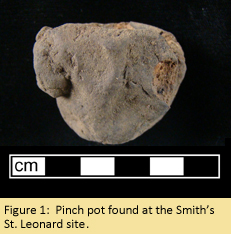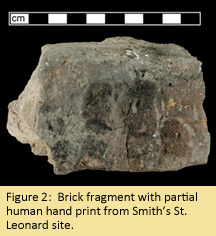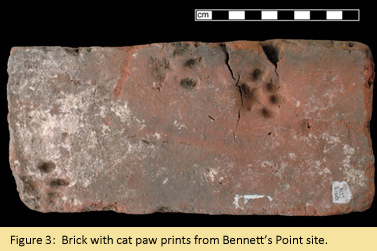The Personal Touch
September 2012
By Annette Cook, MAC Lab Public Archaeology Asst.
 Archaeologists study past humans by investigating the "stuff" they left behind. These remains are used to figure out how groups of people lived their lives and interacted with one another. Sometimes, however, we are lucky enough to find an object that connects us with an individual from the past in a very personal way.
Archaeologists study past humans by investigating the "stuff" they left behind. These remains are used to figure out how groups of people lived their lives and interacted with one another. Sometimes, however, we are lucky enough to find an object that connects us with an individual from the past in a very personal way.
In 2011, while excavating a mid-18th century cellar in the kitchen of the Smith's St. Leonard site on Jefferson Patterson Park and Museum in Calvert County, MD a small, clay pinch pot was found (Figure 1). The pot was mostly intact, about the size of a small plum, with clear finger impressions and pinch marks. A host of other ceramic sherds were found in the cellar, mostly European-made imports, but also including fragments of other pinch pots, covered with the ridges and whorls of the fingerprints of their makers. These vessels were roughly made and low fired, if they were fired at all.
 In the same cellar, a brick fragment was discovered with the clear impression of four fingers of a human’s right hand (Figure 2). While the brick-making process certainly gave ample opportunity for such prints to be left behind, it is the only such handprint-marked fragment found at Smith’s St. Leonard thus far.
In the same cellar, a brick fragment was discovered with the clear impression of four fingers of a human’s right hand (Figure 2). While the brick-making process certainly gave ample opportunity for such prints to be left behind, it is the only such handprint-marked fragment found at Smith’s St. Leonard thus far.
So what is it about finger/hand prints that peaks interest? For me, it is the human connection-- the awe-inspiring moment when you realize you are seeing actual physical evidence of a specific person performing a specific activity. In my imagination I see a child making pinch pots while her mother works in the kitchen. Perhaps she offers them to her mother in the universal and timeless "look what I made" manner of children happy with their creations. Possibly a brick maker, tired at the end of a long day's labor, was not as careful as he usually would be. Or maybe the wet bricks just proved too great a temptation for someone to pass up.
 Other marked artifacts inspire a different type of "awww." Another brick found at Smith's St. Leonard bears clear paw prints, possibly those of a cat. The Maryland Archaeological Conservation Laboratory houses similar artifacts from other sites, including a complete brick with several probable cat paw prints from Bennett's Point in Queen Anne’s County (Figure 3) and a brick fragment with a large canine footprint from Oxon Hill Manor in Prince George's County (Figure 4). Who doesn’t love puppies and kitties?
Other marked artifacts inspire a different type of "awww." Another brick found at Smith's St. Leonard bears clear paw prints, possibly those of a cat. The Maryland Archaeological Conservation Laboratory houses similar artifacts from other sites, including a complete brick with several probable cat paw prints from Bennett's Point in Queen Anne’s County (Figure 3) and a brick fragment with a large canine footprint from Oxon Hill Manor in Prince George's County (Figure 4). Who doesn’t love puppies and kitties?
These artifacts serve to remind us that the objects we study are linked to people, who, for all their dissimilar times and circumstances, were probably not all that different from us.